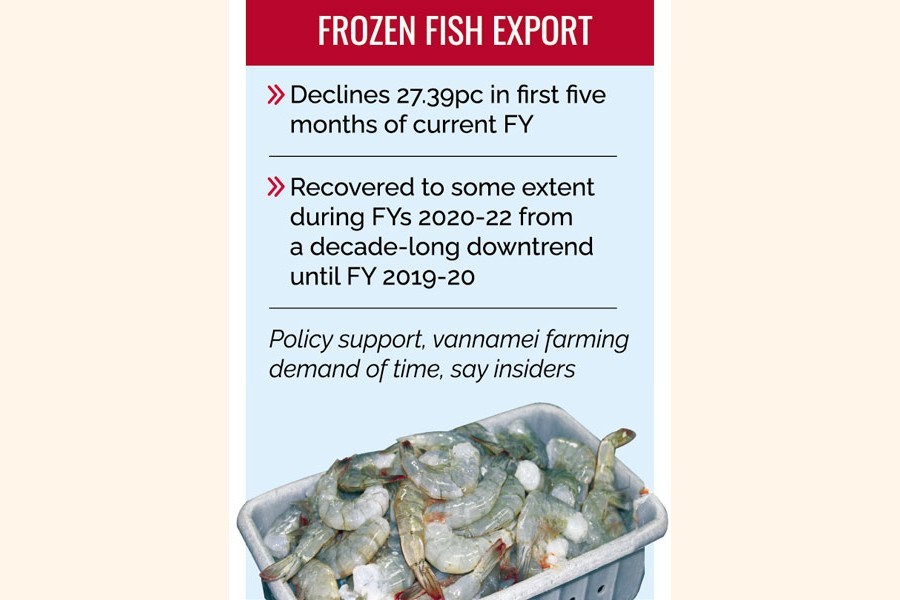No comforting prospect for frozen fish export
Sector people urge remedies to rescue forex-earners

Published :
Updated :

Signs of a possible recovery of the forex-earning sector during the last two fiscal years from a decade-long downturn are fading out as the exports of frozen-fish products and live fish start falling again.
The earnings fell by 27.39 per cent to US$208.27 million during the first five months of the current fiscal year (FY 2022-23) from $286.85 million in the corresponding period (Jul-Nov) of last FY, according to the latest Export Promotion Bureau (EPB) data.
Industry insiders attribute the reversal to a decline in the demand for the expensive fish products in the up markets, mainly in the European Union, under the influence of high-rated inflation amid the Russia-Ukraine war.
"Another major reason is that we could not introduce low-cost variety of shrimp like vannamei despite making several attempts over the years," says one of them.
Export of the item has been on the decline for over a decade apparently due to the scarcity of raw materials and the fall in global demand for the expensive local varieties of shrimp, they pointed out.
In FY 2010-11, the export earnings from local frozen and live fishes, including shrimp, stood at $625.04 million and has been on a slide since, except for FY '14 when the sector earned the highest $638.19 million.
The downward trend continued until FY 2019-20 to reach $456.15 million, before recovering to some extent in the following two FYs - the export earnings rose to US$477 million and US$532.94 million respectively in FY 2020-21 and FY 2021-22, EPB data show.
Fish and shrimp exporters say both prices and demand for frozen fish declined in the major markets, especially in the European Union, because the global market is flooded with vannamei.
Local production of shrimp has been declining for years due to shortage of raw materials, scarcity of farming areas and lack of policy support, they pointed out.
Moreover, in the recent months, local fish exporters were facing a severe crisis due to stockpile of exports as the Russia-Ukraine war has severely dented the global demand for the expensive item, they added.
Bangladesh Frozen Foods Exporters Association (BFFEA) president Amin Ullah, on December 04, in a letter to commerce minister Tipu Munshi also expressed concern over the sector's downturn over the last decade.
Explaining the reasons, in a separate letter to the Department of Fisheries, the association cited a number of causes like reduction in production, losing competitiveness on the global market, absence of required infrastructure and entrepreneurs' apathy due to inadequate banking facilities, risk-management coverage and no incentives at cultivation level.
The BFFEA said, "The production cost of local varieties of shrimp is very high as the traditional way of cultivation is still followed largely."
Mr Amin in the letter to the commerce ministry said a significant portion of exportable shrimps was being sold in local markets at low prices due to decline in global demand and fall in prices, and the country, as a result, is being deprived of export earnings.
The government is providing 20-percent cash incentives against the export of several agricultural products, he said, demanding an increase in the rate of incentives for the sector, too, to 20 per cent for the next two years from the existing 10 per cent. "It would help exporters survive."
The BFFEA president also requested the commerce minister to issue a demi official letter to the fisheries ministry so that it allows commercial production of Vannamei shrimps in Bangladesh and to ensure availability of raw materials for the frozen-fish-export sector.
When asked, he said exports witnessed growth during the last two FYs, but it was still lower than the earnings of what it was five years back.
He noted that both price and demand went up in the global markets for the period due to withdrawal of the COVID-induced lockdowns, followed by resumption of economic activities.
Regarding the introduction of commercial cultivation of vannamei, Mr Amin blamed bureaucracy and some other 'unknown' reasons for not starting the cultivation in the country despite the piloting done long before and its outcome being encouraging.
The piloting of vannamei farming was successful as the yield stood at 10 tonnes per hectare as compared to only 2.0 tonnes for local baghda shrimp.
Industry insiders, however, opine that a group of people does not want vannamei to be commercially cultivated as they thought it could damage the local varieties.
Another "vested-interest group, especially NGOs, is also against vannamei as they could bring funding for local baghda farming, they alleged.
They want that the government allow a certain area for vannamei farming with hatcheries and other required infrastructure and guidelines in this regard for a breakthrough.
Fifteen years have already elapsed and other countries have already introduced the vannamei variety of shrimp, they pointed out, adding that the government officials concerned have yet to sit for reviewing the outcome of the pilot project and report to the fisheries ministry.
An exporter says the Russia-Ukraine war has deepened the crisis of the sector which was facing the pandemic fallouts.
"Due to high inflation, the EU consumers spend less on shrimps as they consider it a luxury," he notes.
Talking to the FE, Maqsudur Rahman, a fish exporter, mentioned shortage of raw material, absence of required banking support and failure to cultivate vannamei as the main reasons.
Set up in 1983, his factory had to suspend production in 2011, he said.
The former leader of BFFEA further said at present only 35-40 fish- processing plants are active across the country which were more than 160 in number decades back.
Commercial cultivation of Vannamei variety of shrimps could help the sector survive, exporters say, adding that the consumers prefer this small-sized high-yielding variety due to its low price.
Munni_fe@yahoo.com


 For all latest news, follow The Financial Express Google News channel.
For all latest news, follow The Financial Express Google News channel.